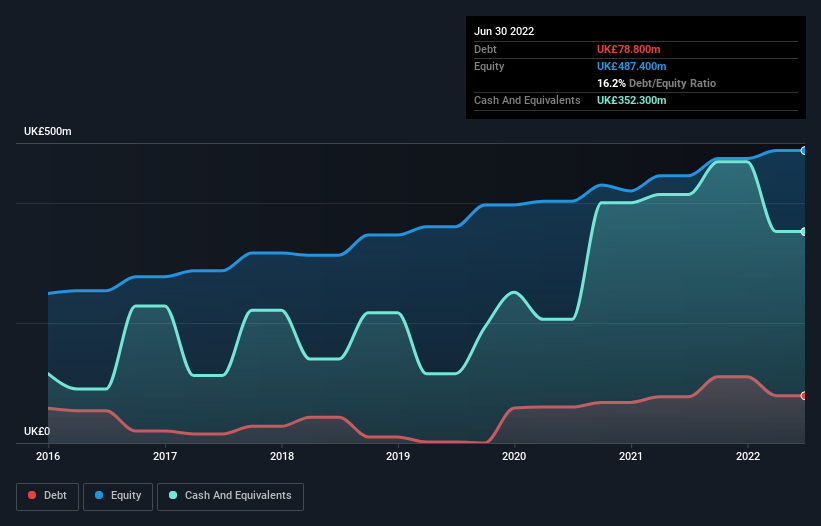- United Kingdom
- /
- Construction
- /
- LSE:MGNS
Morgan Sindall Group (LON:MGNS) Seems To Use Debt Rather Sparingly
Warren Buffett famously said, 'Volatility is far from synonymous with risk.' When we think about how risky a company is, we always like to look at its use of debt, since debt overload can lead to ruin. We note that Morgan Sindall Group plc (LON:MGNS) does have debt on its balance sheet. But the real question is whether this debt is making the company risky.
When Is Debt Dangerous?
Debt and other liabilities become risky for a business when it cannot easily fulfill those obligations, either with free cash flow or by raising capital at an attractive price. If things get really bad, the lenders can take control of the business. However, a more frequent (but still costly) occurrence is where a company must issue shares at bargain-basement prices, permanently diluting shareholders, just to shore up its balance sheet. Of course, the upside of debt is that it often represents cheap capital, especially when it replaces dilution in a company with the ability to reinvest at high rates of return. When we examine debt levels, we first consider both cash and debt levels, together.
Check out the opportunities and risks within the GB Construction industry.
How Much Debt Does Morgan Sindall Group Carry?
As you can see below, Morgan Sindall Group had UK£78.8m of debt, at June 2022, which is about the same as the year before. You can click the chart for greater detail. However, its balance sheet shows it holds UK£352.3m in cash, so it actually has UK£273.5m net cash.

How Strong Is Morgan Sindall Group's Balance Sheet?
The latest balance sheet data shows that Morgan Sindall Group had liabilities of UK£1.06b due within a year, and liabilities of UK£105.0m falling due after that. On the other hand, it had cash of UK£352.3m and UK£564.3m worth of receivables due within a year. So it has liabilities totalling UK£247.7m more than its cash and near-term receivables, combined.
Morgan Sindall Group has a market capitalization of UK£676.3m, so it could very likely raise cash to ameliorate its balance sheet, if the need arose. But it's clear that we should definitely closely examine whether it can manage its debt without dilution. Despite its noteworthy liabilities, Morgan Sindall Group boasts net cash, so it's fair to say it does not have a heavy debt load!
In addition to that, we're happy to report that Morgan Sindall Group has boosted its EBIT by 39%, thus reducing the spectre of future debt repayments. The balance sheet is clearly the area to focus on when you are analysing debt. But it is future earnings, more than anything, that will determine Morgan Sindall Group's ability to maintain a healthy balance sheet going forward. So if you're focused on the future you can check out this free report showing analyst profit forecasts.
Finally, a company can only pay off debt with cold hard cash, not accounting profits. While Morgan Sindall Group has net cash on its balance sheet, it's still worth taking a look at its ability to convert earnings before interest and tax (EBIT) to free cash flow, to help us understand how quickly it is building (or eroding) that cash balance. Happily for any shareholders, Morgan Sindall Group actually produced more free cash flow than EBIT over the last three years. There's nothing better than incoming cash when it comes to staying in your lenders' good graces.
Summing Up
While Morgan Sindall Group does have more liabilities than liquid assets, it also has net cash of UK£273.5m. And it impressed us with free cash flow of UK£16m, being 116% of its EBIT. So is Morgan Sindall Group's debt a risk? It doesn't seem so to us. When analysing debt levels, the balance sheet is the obvious place to start. But ultimately, every company can contain risks that exist outside of the balance sheet. We've identified 2 warning signs with Morgan Sindall Group (at least 1 which is significant) , and understanding them should be part of your investment process.
When all is said and done, sometimes its easier to focus on companies that don't even need debt. Readers can access a list of growth stocks with zero net debt 100% free, right now.
New: Manage All Your Stock Portfolios in One Place
We've created the ultimate portfolio companion for stock investors, and it's free.
• Connect an unlimited number of Portfolios and see your total in one currency
• Be alerted to new Warning Signs or Risks via email or mobile
• Track the Fair Value of your stocks
Have feedback on this article? Concerned about the content? Get in touch with us directly. Alternatively, email editorial-team (at) simplywallst.com.
This article by Simply Wall St is general in nature. We provide commentary based on historical data and analyst forecasts only using an unbiased methodology and our articles are not intended to be financial advice. It does not constitute a recommendation to buy or sell any stock, and does not take account of your objectives, or your financial situation. We aim to bring you long-term focused analysis driven by fundamental data. Note that our analysis may not factor in the latest price-sensitive company announcements or qualitative material. Simply Wall St has no position in any stocks mentioned.
About LSE:MGNS
Morgan Sindall Group
Operates as a construction and regeneration company in the United Kingdom.
Outstanding track record with flawless balance sheet and pays a dividend.
Similar Companies
Market Insights
Community Narratives





